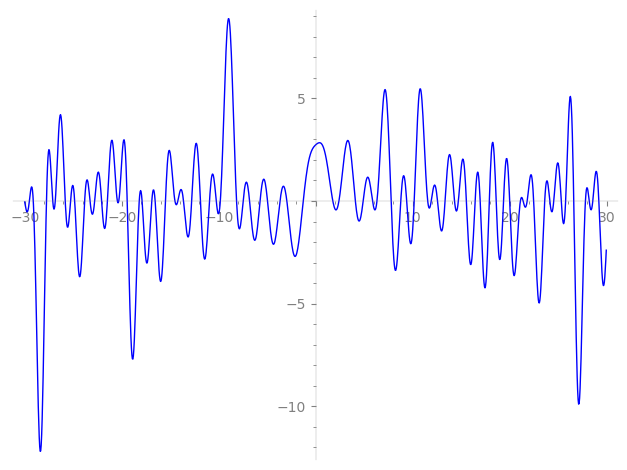| L(s) = 1 | + (0.965 + 0.258i)2-s + (0.866 + 0.499i)4-s + (1.48 + 1.67i)5-s + (1.13 − 4.23i)7-s + (0.707 + 0.707i)8-s + (1 + 2i)10-s + (1.22 − 0.707i)11-s + (−1.5 − 5.59i)13-s + (2.19 − 3.79i)14-s + (0.500 + 0.866i)16-s + (4.38 − 4.38i)17-s + 3.19i·19-s + (0.448 + 2.19i)20-s + (1.36 − 0.366i)22-s + (−4.82 + 1.29i)23-s + ⋯ |
| L(s) = 1 | + (0.683 + 0.183i)2-s + (0.433 + 0.249i)4-s + (0.663 + 0.748i)5-s + (0.428 − 1.59i)7-s + (0.249 + 0.249i)8-s + (0.316 + 0.632i)10-s + (0.369 − 0.213i)11-s + (−0.416 − 1.55i)13-s + (0.585 − 1.01i)14-s + (0.125 + 0.216i)16-s + (1.06 − 1.06i)17-s + 0.733i·19-s + (0.100 + 0.489i)20-s + (0.291 − 0.0780i)22-s + (−1.00 + 0.269i)23-s + ⋯ |
\[\begin{aligned}\Lambda(s)=\mathstrut & 810 ^{s/2} \, \Gamma_{\C}(s) \, L(s)\cr =\mathstrut & (0.993 + 0.116i)\, \overline{\Lambda}(2-s) \end{aligned}\]
\[\begin{aligned}\Lambda(s)=\mathstrut & 810 ^{s/2} \, \Gamma_{\C}(s+1/2) \, L(s)\cr =\mathstrut & (0.993 + 0.116i)\, \overline{\Lambda}(1-s) \end{aligned}\]
Particular Values
| \(L(1)\) |
\(\approx\) |
\(2.73396 - 0.160451i\) |
| \(L(\frac12)\) |
\(\approx\) |
\(2.73396 - 0.160451i\) |
| \(L(\frac{3}{2})\) |
|
not available |
| \(L(1)\) |
|
not available |
\(L(s) = \displaystyle \prod_{p} F_p(p^{-s})^{-1} \)
| $p$ | $F_p(T)$ |
|---|
| bad | 2 | \( 1 + (-0.965 - 0.258i)T \) |
| 3 | \( 1 \) |
| 5 | \( 1 + (-1.48 - 1.67i)T \) |
| good | 7 | \( 1 + (-1.13 + 4.23i)T + (-6.06 - 3.5i)T^{2} \) |
| 11 | \( 1 + (-1.22 + 0.707i)T + (5.5 - 9.52i)T^{2} \) |
| 13 | \( 1 + (1.5 + 5.59i)T + (-11.2 + 6.5i)T^{2} \) |
| 17 | \( 1 + (-4.38 + 4.38i)T - 17iT^{2} \) |
| 19 | \( 1 - 3.19iT - 19T^{2} \) |
| 23 | \( 1 + (4.82 - 1.29i)T + (19.9 - 11.5i)T^{2} \) |
| 29 | \( 1 + (-2.82 - 4.89i)T + (-14.5 + 25.1i)T^{2} \) |
| 31 | \( 1 + (3.09 - 5.36i)T + (-15.5 - 26.8i)T^{2} \) |
| 37 | \( 1 + (-5.19 - 5.19i)T + 37iT^{2} \) |
| 41 | \( 1 + (-1.10 - 0.637i)T + (20.5 + 35.5i)T^{2} \) |
| 43 | \( 1 + (7.09 + 1.90i)T + (37.2 + 21.5i)T^{2} \) |
| 47 | \( 1 + (-0.776 - 0.208i)T + (40.7 + 23.5i)T^{2} \) |
| 53 | \( 1 + (-2.26 - 2.26i)T + 53iT^{2} \) |
| 59 | \( 1 + (-1.48 + 2.56i)T + (-29.5 - 51.0i)T^{2} \) |
| 61 | \( 1 + (1.90 + 3.29i)T + (-30.5 + 52.8i)T^{2} \) |
| 67 | \( 1 + (5.73 - 1.53i)T + (58.0 - 33.5i)T^{2} \) |
| 71 | \( 1 - 10.1iT - 71T^{2} \) |
| 73 | \( 1 + (-4 + 4i)T - 73iT^{2} \) |
| 79 | \( 1 + (1.90 - 1.09i)T + (39.5 - 68.4i)T^{2} \) |
| 83 | \( 1 + (3.67 - 13.7i)T + (-71.8 - 41.5i)T^{2} \) |
| 89 | \( 1 + 1.69T + 89T^{2} \) |
| 97 | \( 1 + (2.19 - 8.19i)T + (-84.0 - 48.5i)T^{2} \) |
| show more | |
| show less | |
\(L(s) = \displaystyle\prod_p \ \prod_{j=1}^{2} (1 - \alpha_{j,p}\, p^{-s})^{-1}\)
Imaginary part of the first few zeros on the critical line
−10.25092002112120548496790566753, −9.835066832792376573415548058059, −8.160564131771560968656705058437, −7.47953077830390740868421141489, −6.81943072342040915056363109810, −5.73864143601038929298284735871, −4.96981767440499036773132554945, −3.68291766453689388369064808400, −2.97590267053564697122951839483, −1.28477549528742574636731711102,
1.76342370584210513215646323170, 2.39196470727830129730738437731, 4.08749008622981947767824024638, 4.89068847558604093024365212196, 5.85859745162081054364196288943, 6.31131387360741842596236458312, 7.76898062026949532823054109995, 8.767337210754313782165812470197, 9.375657169057014642223748244541, 10.15022065572565177060281264294

